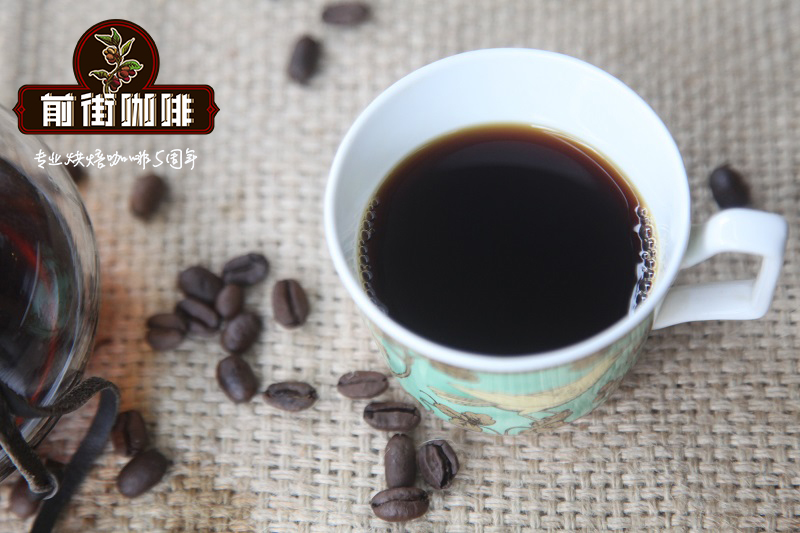Why American coffee tastes sour | can you drink it when it's sour? | Coffee has sour taste.

Professional coffee knowledge exchange more coffee bean information please follow the coffee workshop (Wechat official account cafe_style)
Shouldn't coffee be bitter? Why does American coffee taste sour? Can I still drink the coffee when it's sour?
People who don't drink coffee very much will wonder why when they suddenly drink some fine coffee. This thing is not bitter? Why is it still sour?
To put it simply, it is because coffee is rich in organic acids, aromatic hydrocarbons, proteins, lipids, alkaloids and carbohydrates, which produce a variety of interesting fragrances, sour, sweet and bitter after baking. Today, let's talk about the sweet and sour fragrance of coffee beans. This knowledge can help you choose coffee beans, roast raw beans, and make coffee.
Chlorogenic acid, a healthy but unpalatable acid in coffee
Coffee is actually an acidic drink, and a very important part of tasting boutique coffee is to appreciate its rich sour taste. Most of the boutique coffee uses Arabica coffee beans (Arabica), while the common commercial beans choose Robusta coffee beans (Robusta). And Robusta coffee beans have more chlorogenic acid (Chlorogenic Acid), chlorogenic acid is also called coffee tannin, this acid is not delicious, insects do not like to eat, so Robusta coffee trees usually have better anti-insect power.
Not only insects do not like chlorogenic acid, in fact, humans do not like the bitter taste of chlorogenic acid, although it is actually a good antioxidant and good for health. But the good news is that chlorogenic acid turns into quinic acid and caffeic acid during coffee roasting, which is one of the reasons why coffee is less sour as it is roasted deeper.
Boutique coffee has less chlorogenic acid, so light roasting will not be too sour, while Robusta coffee beans are mostly roasted in use so that they will not be too sour to swallow. But this is only a statement in the general direction, not certain.
Wait, isn't the boutique coffee sour? Then why is there less chlorogenic acid in boutique coffee and sour?
Because the multi-level, bright and interesting sour taste of boutique coffee is not made by the sour taste of chlorogenic acid alone, chlorogenic acid is actually a kind of bitter acid. Most of the delicious acids in boutique coffee are brought by citric acid, malic acid, quinic acid, acetic acid and tartaric acid, but it is much more than that, because coffee beans contain thousands of chemicals that affect flavor. But today, Qianjie Coffee will first introduce the flavors of these major influences.
Malic acid and citric acid that do not match the name
Malic acid and citric acid sound very youthful and colorful, but do you know? In fact, malic acid and citric acid do not have the aroma of fruit, because they are not volatile, so they can not smell. They are called malic acid and citric acid only because apples and lemons are rich in these two acids.
But! If malic acid and citric acid, run to combine with alcohol, you can pop out a lot of flowers, fruit, fragrance and other charming fragrance, this is the main source of aroma of raw beans, ripe beans.
And quinic acid and tartaric acid.
Quinic acid is degraded by chlorogenic acid, and it is not clear whether it brings astringency to coffee. Or add a bright flavor to the coffee. There are a lot of people saying both of these things, but the editor thinks that these two things do not conflict with each other, do you know? In fact, a little bit of odor will be added to the powerful perfume to improve the hierarchical sense of the fragrance.
Tartaric acid is commonly found in fruits such as grapes and bananas, and it is also one of the main organic acids in wine. With these acids, and coffee beans in a variety of carbohydrates, lipids, produce a variety of chemical changes, can produce a variety of acids, fragrance, sweet.
The relationship between acid and sucrose in fine coffee
More interestingly, the bright and lively acidity of coffee is proportional to the amount of sucrose in coffee beans, and the amount of sucrose in coffee beans also has a lot to do with origin and altitude.
For example, coffee beans from Kenya have a strong, individual sour taste, with a sucrose weight ratio of 8.45%, followed by Colombia with 8.3%, which is why Colombian coffee beans are often used to regulate sour taste in Italian beans.
In the case of Africa, African coffee beans usually have high sucrose, as well as obvious acidity and fruit aroma. Followed by South America, with a more mild and non-irritating supple sour aroma.
In addition, according to the study, for every 100 meters increase in altitude, the temperature decreases by 0.6 degrees Celsius, and every 300 meters increase the sucrose content of coffee beans by 10%. This is because higher altitude, lower temperature and large temperature difference between day and night can slow down the growth rate of coffee and store more nutrients. Sucrose produces more sour substances in the process of baking, which is why the sour aroma of hard beans at high altitude is much better than that of soft beans at lower altitudes.
Roasting removes the acid from coffee
Friends who believe they have baked beans know that the deeper the roast, the more acid in the coffee will be destroyed and replaced by more caramel, smoky and bitter taste. Therefore, it is not common for boutique coffee to be moderately roasted and more ripe. Of course, just because it's rare doesn't mean it won't work. Deep roasting of boutique coffee beans is an interesting skill. Friends who bake their own beans can try to see how sour the same kind of beans feel at different roasting degrees.
End
Important Notice :
前街咖啡 FrontStreet Coffee has moved to new addredd:
FrontStreet Coffee Address: 315,Donghua East Road,GuangZhou
Tel:020 38364473
- Prev

Confidence from Coffee countries: a brief talk on the Culture and Development History of Italian Coffee
Professional coffee knowledge exchange more coffee bean information please follow the coffee workshop (Wechat official account cafe_style) Italy, in people's perception is a literary, lazy, enjoy life of a country. When it comes to Italy, the first thing that comes to mind is the Renaissance. It took place during the ideological and cultural movement in Europe from the middle of the 14th century to the 16th century.
- Next

What do you need to pay attention to when making ice drop coffee? why is ice drop coffee called Dutch coffee
Professional coffee knowledge exchange more coffee bean information Please pay attention to the coffee workshop (Wechat official account cafe_style) the principle of ice drop coffee is the process of extracting flavor substances from coffee powder by dripping ice bit by bit at a uniform rate, based on the fact that coffee itself is soluble with water. The ice water at the top of the container is controlled by the valve, a drop of soaked coffee powder, and the coffee liquid passes by.
Related
- Beginners will see the "Coffee pull flower" guide!
- What is the difference between ice blog purified milk and ordinary milk coffee?
- Why is the Philippines the largest producer of crops in Liberia?
- For coffee extraction, should the fine powder be retained?
- How does extracted espresso fill pressed powder? How much strength does it take to press the powder?
- How to make jasmine cold extract coffee? Is the jasmine + latte good?
- Will this little toy really make the coffee taste better? How does Lily Drip affect coffee extraction?
- Will the action of slapping the filter cup also affect coffee extraction?
- What's the difference between powder-to-water ratio and powder-to-liquid ratio?
- What is the Ethiopian local species? What does it have to do with Heirloom native species?

